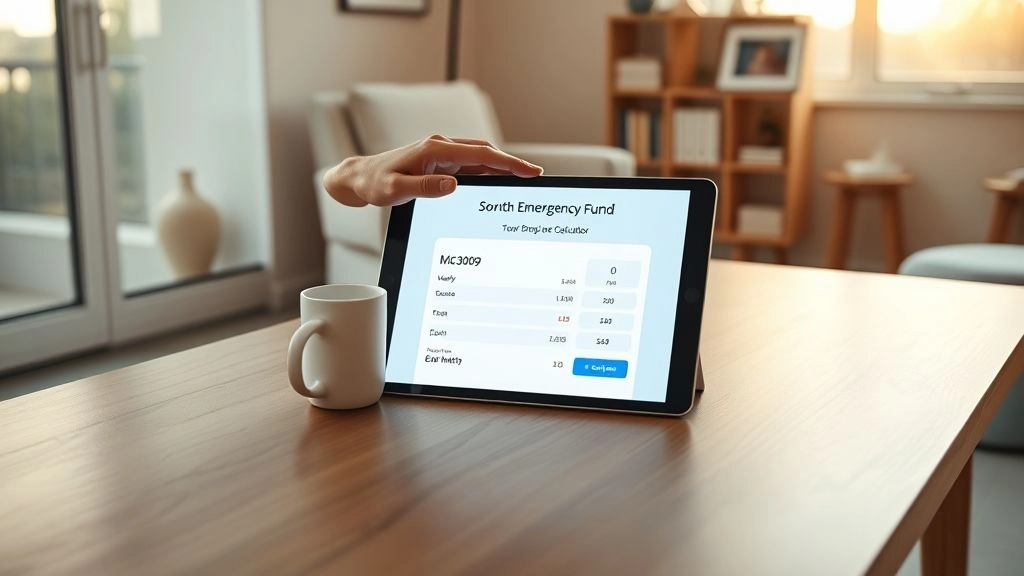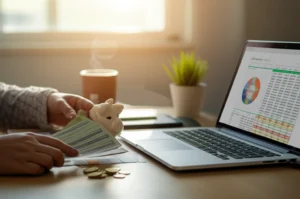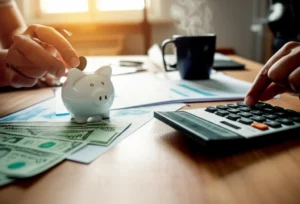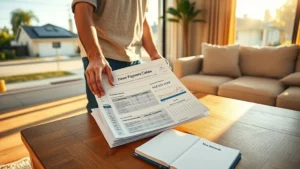How Fast Do Little Things Add Up?
Can I start with a confession? I used to spend $5—sometimes more—on coffee every morning. Just a little splurge, I thought. But then I did the math and… yikes. That’s $1,825 a year. Wild, right? Imagine if you put just half of that in a jar for rainy days. That’s how real people, not just spreadsheet junkies, build up an emergency fund—a small trick, repeated over and over, that turns pocket change into a serious safety net.
Today, let’s dig into the Emergency fund calculator (don’t worry, I’ll keep it low-key, not math-class-vibes). I’ll walk you through figuring out your number, why it’s worth it, and the weird ways life tests us. We’ll talk about stash spots, frugal hacks that don’t suck, and share stories from folks who turned grocery money into peace of mind. Sip your coffee (homemade, maybe?) and let’s get started.
Why Even Bother?
What’s Really an “Emergency” Anyway?
You ever notice the universe loves a good surprise? Nothing like “You’ve Been Laid Off!” or “Hey, your car’s making a weird noise” to spice up your week. But here’s something most people never say out loud: emergencies happen to everyone. Even the Uber-frugal, meal-prepping, coupon-clipping crowd. Does it sting less when you’re ready? Oh yes.
Let’s get real, though—sometimes our emergencies aren’t billboard big, just quietly annoying. A friend of mine, Kelly, got a parking ticket, failed her fridge, and chipped a tooth—all in one month. She didn’t panic. She had a little “just in case” stash, so she handled it like, “Cool, I’ve got this.” That’s the feeling you’re chasing: not rich-kid vibes, just… calm. You don’t lose sleep or scramble for a loan. You just handle things.
Fit It into Your Actual Life
Let’s make this personal. How the heck do you know what your “enough” is? Enter: Emergency fund calculator. Instead of aiming for some random number, it’s about your rent, groceries, and bills. No two people’s safety nets will be the same—and that’s good news. The NerdWallet tool and other calculators like it basically let you punch in your reality and get a savings goal that feels doable, not overwhelming.
But the goal isn’t to have some blog-perfect emergency money account. It’s to ease your mind and avoid those gnarly “uh-oh, the credit card’s maxed” moments.
Make Your Number—Here’s How
What’s Essential? (Like, Really?)
This is the part where you put on your “truth goggles.” Take 10 minutes and peek at your bank statements. What has to be paid every month? I’m talking:
- Rent or mortgage
- Groceries (the real number, not the “optimistic” one)
- Health insurance
- Utilities
- Minimum debt payments
- Transport—gas or subway pass (unless you’re walking everywhere)
Add it all up. That’s your baseline. Not optional stuff—just what you need to cover if everything else went sideways. Some folks average three months for the minimum cushion, others choose six. There’s no “wrong amount”—just your comfort zone. The Emergency fund calculator uses this number—and if you want, you can bump it higher for more breathing room.
What If Life Throws You a Curveball?
Here’s where life experience comes in. Do you have kids? A complicated job situation? Are you self-employed? You might want a thicker safety net than your nine-to-five-forever friend. For some people, three months of expenses covers “normal” risks… for others, twelve is safer. That’s what makes the Emergency fund calculator awesome: you can tweak it by your life, not just a rule of thumb.
| Scenario | Monthly Expenses | Target Fund (3 months) | Target Fund (6 months) |
|---|---|---|---|
| Single, renting | $1,800 | $5,400 | $10,800 |
| Family, mortgage | $4,500 | $13,500 | $27,000 |
| Self-employed, kids | $5,000 | $15,000 | $30,000 |
And if those numbers feel ridiculous, you’re not alone. A lot of folks worry they’ll never fill a $30,000 emergency fund. Totally normal. But every $100 gets you closer to being the calm-in-a-crisis person, not the “Google panicking at 1am” person. For high goals, see the $30,000 emergency fund tips—it’s more about small steps than giant leaps.
Where to Stash Your Cash (But Really)
Isn’t My Checking Account Enough?
Oh man, I used to keep my “emergency” money in checking. Want to guess how many ’emergencies’ involved takeout or late-night Amazon? (Answer: too many.) Here’s the thing—temptation is real.
Why shouldn’t you keep your emergency fund money in your checking account? One, it’s too easy to “borrow” from yourself for anything that isn’t a true emergency. Two, checking accounts barely pay any interest, so your money’s just sitting there, not even breaking a sweat. The smarter move is a separate high-yield savings account—money earns more and you’re less likely to dip for random stuff. More safety, more growth.
Emergency Fund vs. Regular Savings—What’s the Difference?
This can get confusing. If you asked me two years ago, I would have guessed they’re the same. Turns out, they’re not. Wondering how is an emergency fund similar to and different from a savings fund? Here’s the gist: both are designed to help you avoid debt or financial freak-outs—but regular savings is for stuff you expect (holidays, new shoes, college), while emergency funds are for stuff you absolutely don’t see coming (job loss, surprise surgery). If you use your “emergency” money for plane tickets, you might regret it when the car goes kaput. Check out more on how is an emergency fund similar to and different from a savings fund?—it’s clearer with examples, promise.
P.S. Sometimes people keep both funds at the same bank but with a separate nickname. Out of sight, out of “oops I spent it”.
Frugal Ways to Fill That Fund
Tiny Swaps That Make a Big Splash
OK, so you know how much you need and where to keep it. But how do you get there—especially when everything (eggs! gas!) keeps going up? Here’s the nothing-is-nothing approach: even $5 a week is $260 by year’s end. Maybe that’s only a fraction of your “fully-funded” dream, but it covers a parking ticket or urgent plumber call. Here’s a table to make it more real:
| Weekly Savings | Yearly Total | Months of $1,000 Coverage |
|---|---|---|
| $5 | $260 | 0.26 (about 1 week) |
| $10 | $520 | 0.52 (about 2 weeks) |
| $20 | $1,040 | 1.04 (just past a month) |
What works for me? Automate it. Even if it’s just $10 every payday. Annoying fact: you don’t miss what you never see. Out of sight, into savings. Want more ideas? Check out these real-life Emergency fund examples—lots of folks started with couch change… eventually hit serious goals.
Let’s Get Creative—Fast-Track Tips
Try this: delete one monthly subscription you barely use—maybe it’s a streaming service, maybe a fitness app. Immediately set up a recurring savings transfer for the same amount. Boom, your fund just got a booster shot. Or, sell something you never use (an odd kitchen gadget, or that old iPad?). One reader told me she filled half her starter fund selling clothes online. Another swapped her $4-a-day soda habit for tap water, then funneled the savings into her emergency stash. Is it a sacrifice? Sometimes. But watching that balance grow? Weirdly addictive.
Oh, and tax returns or random bonuses? Pretend they don’t exist. Straight into savings. It’s like tricking yourself… in a good way.
Blunders, Stories, and Small Victories
Guess What? Everyone Slips Up
Here’s a wild story—my cousin “borrowed” from his emergency fund for concert tickets because “the band might never tour again.” (Spoiler: they’ll tour again.) Next month? He broke his ankle, could barely work, and had to charge groceries. Lesson: only take money out for real emergencies. If you’re not sure if it counts, give it a day… or text a frugal friend (that’s me, by the way—DM always open!).
On the flip side, people who hit their goals aren’t unicorns. They just started. Check Emergency fund examples for inspiration. Like, remember that $30,000 emergency fund table above? It didn’t happen overnight. Small steps, rinse and repeat.
Quick Wins—What’s Your Next Move?
- Set up automatic transfers—even $5 counts.
- Give your account a funny nickname (“Hands-Off Fund” works wonders).
- Find a “friend accountability system”—check in once a month.
- Remind yourself: every $50 is one less worry.
Let’s Wrap This Up (and Get You Moving)
Whew… if you made it this far, you’re already serious about building a buffer against life’s messes. Here’s the truth: you don’t need to be a financial expert, or even “good with money,” to use an Emergency fund calculator, pick a number, and start saving. You just need to know your essentials, stash it where you won’t touch it by accident, and nudge a bit in each month.
Don’t sweat a “perfect” account or magic dollar amount. There’s no such thing as too small. The real magic is momentum. So, what’s your next step? Open your banking app and peek at last month’s spending? Set up a $10 transfer? Cancel that streaming service you never watch?
Whatever you do—just start. You’ll thank yourself the next time the universe decides to throw something your way. (Which, let’s be real, it will.) And hey—if you need inspiration or just want to brag about your savings win, send a note. We’re all in this together. You got this!













